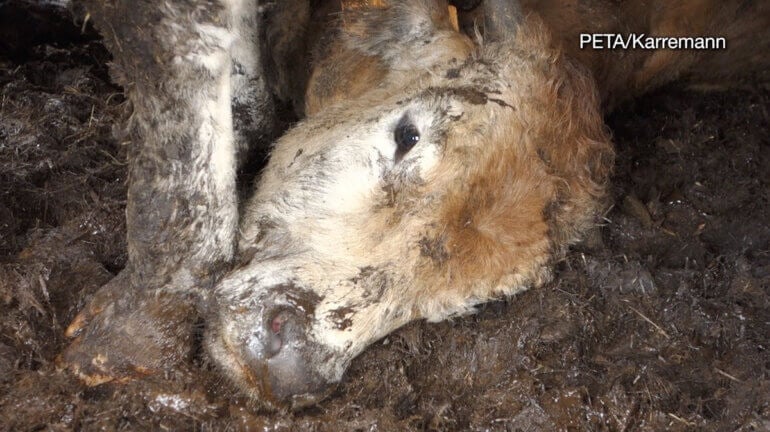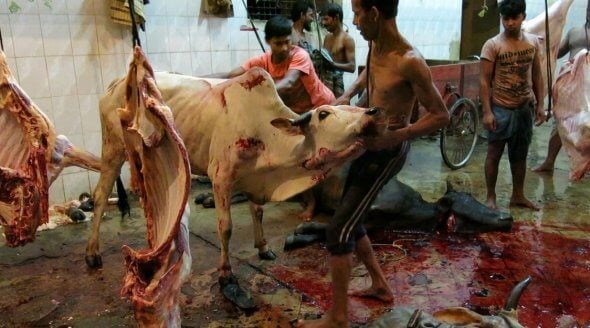The Leather Industry Doesn’t Want You to See This
The leather industry is rife with cruelty. Animals endure a living hell, are routinely castrated and branded with hot irons without any painkillers, and are slaughtered in front of their friends and family members so their skin can be turned into jackets, shoes, belts, bags, and other accessories.
The fashion industry has already turned its back on fur. Now, it’s time it realised that leather is just as cruel and needs to be ditched from catwalks and our wardrobes. Those who peddle leather to consumers put a lot of work into concealing what occurs out of sight in this destructive industry. But the violence has been repeatedly exposed. Everyone needs to know what happens to animals whose skins are turned into leather.
Here are five things the global leather industry doesn’t want you to know:
- Every year, the industry slaughters more than a billion animals.
Before being turned into belts and bags, many animals endure all the horrors of factory farming – including intensive confinement to filthy cages or pens, castration without pain relief, chronic infections and disease caused by extreme crowding, and a terrifying trip to the abattoir.
Investigations into the leather industries in China and India – two of the top three leather-producing nations in the world – have revealed horrific abuse.
The vast majority of the world’s leather comes from China, where, despite years of campaigning by animal protection groups, there are still no penalties for abusing animals in the skins industry.
- Calves are subjected to mutilations that rival medieval torture.
Workers drag calves away from their mothers shortly after birth, then throw them onto the ground to punch holes in their ears. A PETA video exposé of ranches in Brazil reveals that workers branded calves’ faces with hot irons while standing on their heads to hold them still.Workers were also caught on camera electroshocking cows and hitting and jabbing them with metal-tipped sticks. Severe crowding caused the animals to panic and trample each other as workers kicked them and yanked their ears and tails.
- Cats and dogs are also killed for their skin.
When you wear leather, there’s no easy way to know for sure whose skin you’re in.
A PETA Asia undercover investigation revealed that terrified dogs are bludgeoned and killed so that their skin can be turned into leather accessories to be sold around the world. It’s not a quick death.
Some dogs fell unconscious, while others cried out and writhed in agony. Some still struggled to breathe after their throats had been cut and as workers prepared to peel their skin off.
Dogs who were next in line for slaughter wailed and barked as a worker hit them in an effort to get them to walk more slowly. One employee told the investigator that this facility bludgeons and skins 100 to 200 dogs a day. When the video was shot, there were about 300 live dogs in the compound slated for slaughter.
- Leather production damages human health.
A PETA exposé of the leather industry in Bangladesh, narrated by Leona Lewis, shows that leather production is toxic for human health, too.Tanneries use harmful chemicals to prevent animals’ skin from decaying. Unprotected workers, including children, stand barefoot as they soak hides in carcinogenic chemicals, and the noxious waste is then dumped into the river.
As tanning is such a dangerous process, it’s no longer undertaken in most European countries or the US, so operations are moving elsewhere – jeopardising the health of people in other parts of the world so that consumers in the West can continue wearing leather shoes and jackets.
- Leather is an environmental hazard.
The leather industry is poisoning the living world. Because of the massive amounts of manure and slaughter waste, intensive water use, deforestation, and greenhouse-gas emissions involved in its production, leather is the most environmentally damaging material, as confirmed by the 2017 “Pulse of the Fashion Industry” report.The United Nations is calling for a transition away from animal agriculture – which is responsible for nearly a fifth of human-induced greenhouse-gas emissions – in order to protect the environment.
What You Can Do
The best thing you can do for cows and other animals exploited for their skin is to ditch leather for good and buy vegan alternatives.
You can also take action by speaking up for cows. Levi’s is known around the world for being the original blue-jeans brand – but what many of its customers don’t realise is that cows suffer for the leather patches sewn onto the backs of its jeans. The company knows that cruelty is inherent in the leather industry, but it’s refusing to help animals.
Innovative vegan leather options that mimic the style and look of leather are readily available, and more consumers than ever are wearing vegan out of concern for animals and the environment. Please ask Levi’s to commit to using only vegan leather patches.






